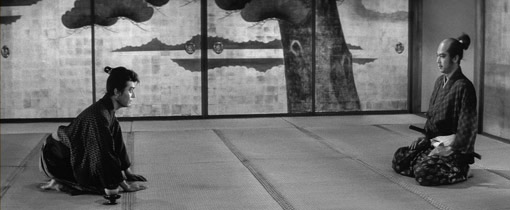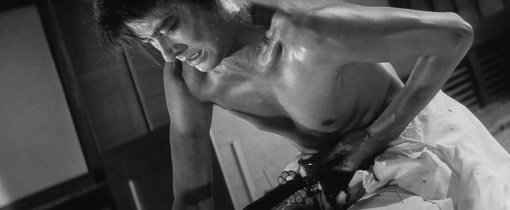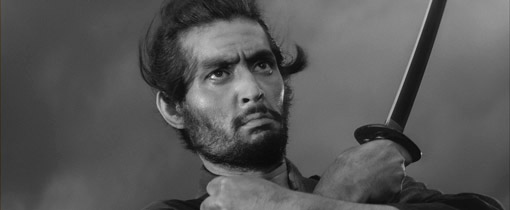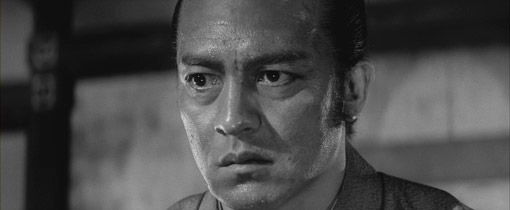"This thing we call samurai honour is ultimately nothing more than a façade." |
Rōnin Tsugumō Hanshiro |
There may well be others, but it's hard to think of another Japanese film whose title has been changed for international release from one Japanese word to another. Although released in the west as Harakiri, the actual title of Kobayashi Masaki's 1962 slow burn tour-de-force is Seppuku, the formal name for a form of ritual suicide practiced exclusively by the samurai warrior class, one that involves slicing open one's belly and being beheaded by a skilled swordsman who acts as a second. Harakiri is essentially a less formal word for the same (it translates literally as "stomach cutting"), a conversational term that a Japanese friend assures me was rarely if ever committed to print and has largely fallen into disuse. But it's one of the few Japanese words that is widely recognised outside of Japan and whose meaning is understood, at least on an elementary level. It's often mispronounced, one of the most commonly heard variants being the somehow very English sounding "harry-carry."
As a confirmed Japanophile of many years standing, I have something of a dilemma when it comes to this particular aspect of the country's cultural history. While my childhood friends were bewitched with the image of the stealthy black-clothed Ninja, I was entranced by the very idea that there were once warriors as dedicated, disciplined and fearsome as samurai. It's a fascination that followed me into my adult years and was further enhanced by my visits to the country in which they once thrived. But ideologically I should be aghast at the very idea of a society in which the nobility is protected by private armies that had the right to execute commoners on the spot for crimes as trivial as not showing an appropriate level of respect. And were they still active today I probably would. The passing of time all too handily distances us from the reality of romanticised history, which is how we can watch tales of Arthurian knights and not be depressed by the thought that their raison d'être was to protect a monarchy that had no moral right to rule.

It's the same story with seppuku, which tradition has painted as an honourable death, one as steeped in pomp and ritual as a catholic marriage. As someone who has dealt with the consequences of suicide on more than one occasion, I struggle to accept that there is anything noble in taking your own life, particularly if it involves slicing your stomach open and having your head lopped off. But in historical and dramatic terms it's something I accept as an essential component of any cinematic samurai story. Of course, by making the ritual the title of his film, director Kobayashi Masaki – who two years later would make the legendary Kwaidan – makes an up-front announcement that it will likely be somewhat more than a plot detail here. And given how this particular narrative plays out, I'm clearly not the only one who has questions about the concept of seppuku as an honourable death.
The year is 1630, thirty years after the battle of Sekigahara led to the dawn of the Edo period and two hundred and fifty years of stability for Japan. This extended peace saw a reduction in the power of the territorial lords, which had the knock-on effect of putting thousands of samurai out of work. Prevented from undertaking manual labour by the country's strictly observed social code, many of these now masterless warriors (known as rōnin, another Japanese word that has burrowed its way into the English language) were plunged into poverty.
One such unfortunate is Tsugumō Hanshiro (Nakadai Tatsuya), who at the start of the film approaches Soto Sakurada-machi, the official residence of the Iyi clan in Edo, to seek permission to end his unhappy existence and commit seppuku in their forecourt in accordance with samurai convention. With the Iyi clan lord absent, his chief counsellor Saitō Kageyu (Mikuni Retarō) grants Tsugumō an audience and hears his request. It's all very civilised, with the conversation regarding Tsugumō's impending death conducted with the good natured politeness of two old friends discussing the weather over tea. Saitō appears sympathetic to Tsugumō's request, but before giving him the go-ahead, he relates to him the story of a younger samurai named Chijiiwa Motome (Ishihama Akira), who approached the Iyi lord with a similar request just a few months earlier.

At this point it looks very much as if Tsugumō's arrival and departure, whatever form the latter will eventually take, will be no more than bookends to Chijiiwa's story, which subsequently unfolds in lengthy and uninterrupted flashback. Like Tsugumō, Chijiiwa arrives at the Iyi residence requesting permission to commit seppuku in their courtyard. But the Iyi officials have become aware that a number of rōnin have been been making similar requests at other clan strongholds, where they have either been offered employment or given money and sent on their way. This, they believe, is encouraging increasing numbers of destitute rōnin to insincerely request permission to commit seppuku on clan ground in the hope of receiving payment, a practice the Iyi are keen to discourage. Believing that Chijiiwa is similarly motivated, they grant his request, refusing his pleas to be allowed to complete one final task and demanding that he carry out the ritual with the bamboo blade that poverty has forced him to trade in his short sword for.
It's at this point that the very idea of seppuku as an honourable death is startlingly challenged. The Iyi speak to Chijiiwa of their admiration for his devotion to the bushidō code, but these are hollow words designed solely to manipulate the young rōnin through his fear of dishonour, which they back up with assurance that he will suffer a far less dignified death should he hesitate in his task. By forcing him to use an essentially ornamental blade, their attempt to make an example of the unfortunate rōnin exposes their own professed code of honour as a shallow justification for brutal sadism. And brutal it is. After two grisly failed attempts to pierce his stomach with a blade that would struggle to cut soft bread, the desperate Chijiiwa falls forward on the weapon and uses his body weight to force it to penetrate his flesh. It's a genuinely horrifying sequence, with the blackness of the blood (how much more shocking profuse bleeding can look in monochrome), the expressionist twists of Miyajima Yoshio's camera, and the agonised expressions on actor Ishihama Akira's face transforming a centuries-old ritual into a barbaric act of self-mutilation. It's made all the more tortuous for Chijiiwa and viewer alike by the refusal of master swordsman Omodaka Hikokurō (Tanba Tetsurō), the one who first proposed this act of discouragement, to deliver the fatal blow until all of the requisite cuts are made.

By this point we are just thirty minutes in to film whose total running time exceeds two hours, and it soon becomes clear that there is a lot more to Tsugumō's story than early indications suggested. Unlike Chijiiwa, he appears fully prepared to go through with the ritual, but when he requests that Omodaka act as his second, the procedure is brought to a temporary halt. Omodaka is not present, having requested a few days rest due to an unspecified illness, but with Tsugumō's heart set on the master swordsman's skills, a messenger is sent to request his attendance. To pass the time while they wait, Tsugumō asks that he be allowed to tell the assembled clansman something about himself, and in the process reveals both the back story to Chijiiwa's arrival at the Iyi residence and his own reason for selecting their forecourt to commit seppuku.
It's here that the real emotional impact of the film resides, as the motives for Chijiiwa's request and his reluctance to see it through gradually become clear. That Tsugumō and Chijiiwa are somehow connected eseems likely from an early stage, but the nature of that bond and the deplorable manner in which Chijiiwa was treated serve to build apprehension about Tsugumō's presence on Iyi clan soil. Does he really intend to commit seppuku, or does he have some other purpose in mind? But given that he is unarmed and surrounded by Iyi samurai, what could that possibly be? And just what mysterious illness appears to have stricken not just Hikokuro, but all three of the seconds requested by Tsugumō?
These individual stories unfold through a combination of flashback and information provided by the disquietingly self-confident Tsugumō, while an increasingly apprehensive Saitō is – as are we – starting to wonder where this is leading. This dual timeline approach opens the story up beyond the confines of the courtyard and bonds us to the tragedy of Chijiiwa's fate, which in spite of the historical and cultural distance, is one with a surprisingly contemporary ring. Like many of his class, Chijiiwa was a dedicated and loyal employee who was stripped of his post and plunged into poverty by government policy, while those in a position of power and privilege misuse the system to their own advantage, whatever the cost to those they abuse. Sound familiar? Such subtext infuses Chijiiwa's already poignant story with a sense of social injustice that we just ache to see rubbed in the Iya's self-righteous faces. That the retribution does not initially take the form we expect brings its own specific pleasures – for a warrior class, humiliation is so much more effective than bloodshed – while the decision to cinematically shy away from the payoffs of flashback conflict (even the first part of a climactic battle is heard rather than seen) leaves us ill prepared for grittily realistic violence of the final ten minutes.

Methodically paced, compellingly performed and constructed primarily from static and formally composed shots – camera movement, angular tilts and even the odd zoom are carefully rationed and immaculately employed – Harakiri is a small masterpiece of slow-build tension, progressive reveal and cinematic restraint, one whose gut-kick drama is potently infused with socio-political overtones that are in no way anchored to the time and place. That we are able to bond so readily with Tsugumō is as much down to the cheerful grace with which he approaches his chosen fate (actor Nakadai Tatsuya is on excellent form here) as it is to our natural sympathy with his moral and physical isolation as he spins his tale within the Iyi forecourt. It's a position emphasised by his decision to wear black instead of the ceremonial white, which can't help but feel symbolic of the film's own questioning of the traditions of jidaigeki cinema and crticism and even rejection of the traditional Japanese notions of honour on which, as Miike Takashi's recent 13 Assassins compellingly demonstrates,* the genre itself continues to thrive.
Nip back a few years and the Masters of Cinema DVD releases of films from Japan's Shōchiku studio tended to fall a little short of the standard we'd even then come to expect from this illustrious label. This was in no way down to MoC, but the quality of the material they were sometimes forced to work with, something we all took on board and made allowances for in the interest of seeing the films released on home video at all. Oh how things have changed. Although also made by Shōchiku back in 1962, Harakiri looks fabulous here, with a rock-solid and virtually spotless picture, punchy contrast, and a consistently crisp level of picture detail. Facial close-ups and content-busy wide shots are once again the best barometers of the resolution difference between DVD and Blu-ray – compare the garden wide shot at the start of chapter 8, and good though the standard definition image is, the HD one leaves it standing in every respect, with a visibly superior tonal richness to the Blu-ray image, while picture information that is indistinct on the DVD is brought sharply into focus. At times this genuinely adds to character and story detail, emphasising Saitō's nervousness by revealing the extent of his facial sweating, and Tsugumō's poverty through the repair stitching on his kimono. The resolution difference also allows for slightly smaller English subtitles on the Blu-ray without sacrificing their clarity.

The DTS-HD Master Audio 2.0 mono on the Blu-ray offers no major advantages over the PCM track on the DVD – the film's vintage ensures an inevitably narrowed dynamic range, and a faint hiss is detectable on the quieter scenes, but the dialogue is clear, and Takemitsu Tōru's haunting, biwa-driven score is impressively reproduced.
Kobayashi Interview (9:07)
An apparently rare interview with director Kobayashi, filmed for the Director's Guild of Japan in 1993. It's conducted by fellow director Shinoda Masahiro, whose CV includes the likes of Assassination (1964), Double Suicide (1969) and Silence (1971), and who frankly does the lion's share of the talking, leaving Kobayashi to smile, nod in agreement and puff on a cigarette while Shinoda expounds on the many virtues of Kobayashi's film. When Kobayashi does speak it's always worthwhile, revealing along the way that Harakiri was in some ways an attempt to challenge Yojimbo-era Kurosawa (something he suggests was actually studio-driven in an interview in the accompanying booklet). He also confesses that after struggling for a while to find a way to make the bamboo sword suicide scene work, he was finally able to crack it by getting drunk.
Original Japanese Trailer (3:09)
An intriguing trailer in reasonably good shape. Inevitably, perhaps, it includes some of the action footage from the later scenes, which really do act as spoilers, so I'd steer clear of this until after the film.
Booklet
Something else you might want to avoid dipping into until after the film, as the included text has its share of plot giveaways, and even the film stills give an indication of what is to come. After seeing the film, though, it's a very worthwhile read, with an authoritative essay on the film by Philip Kemp – who neatly describes the film as "Kobayashi's Anti-Samurai Movie" – and an interview with director Kobayashi, in which he confirms that real swords were used for the combat scenes. Having personally held such a weapon and been startled by its razor-like sharpness, the very idea made me shudder.
It is somewhat ironic that one of the finest of all samurai movies is actually an anti-samurai movie, one in which ritual suicide is portrayed as barbaric, the one-on-one sword-fights do not occur until late in the story and are stripped of their final blows, and samurai honour is shown, in the words of our lead character, to be nothing more than a façade. Beautifully made and impeccably performed, in really shines on this Masters of Cinema dual format release, though the Blu-ray really does come out on top here. Highly recommended.
* Coincidentally, Miike Takashi's most recent feature, Hara-kiri: Death of a Samurai (Ichimei) is also an adaptation of the Takiguchi Yasuhiko story on which Kobayashi's film is based. According to Miike, Kobayashi's film was based on a short story version, whereas for his film he and screenwriter Yamagishi Kikumi adapted Yasuhiko's novel, Ibun rônin-ki. (see here for the interview with Miike from Indie Movies online.)
The Japanese convention of surname first has been used for all Japanese names in this review.
|